Click on images to enlarge
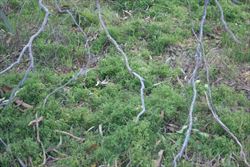
infestation under a tree (Photo: Michael Moerkerk)

habit with tuberous root system (Photo: Michael Moerkerk)
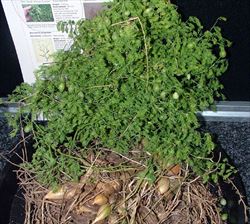
habit with tuberous root system (Photo: Sheldon Navie)
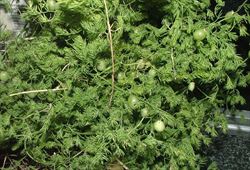
habit (Photo: Sheldon Navie)
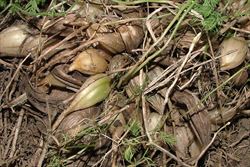
close-up of tubers and rhizomes (Photo: Sheldon Navie)
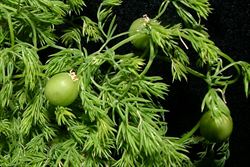
greenish immature fruit (Photo: Sheldon Navie)
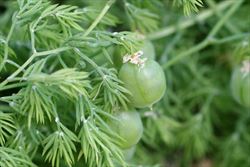
close-up of paler mature fruit (Photo: Michael Moerkerk)
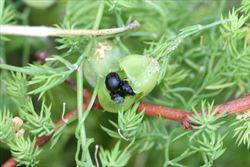
close-up of mature fruit showing its black seeds (Photo: Michael Moerkerk)
Scientific Name
Asparagus declinatus L.
Synonyms
Asparagus crispus Lam.Asparagus decumbens Jacq.Myrsiphyllum declinatum (L.) Oberm.
Family
Asparagaceae (Queensland, New South Wales, the ACT and Western Australia)Liliaceae (Victoria, Tasmania, South Australia and the Northern Territory)
Common Names
asparagus fern, bridal creeper, bridal veil, bridal veil creeper, bridalveil, pale berry asparagus fern, pale-berry asparagus-fern, South African creeper
Origin
Native to southern Africa (i.e. Namibia and Cape Province in South Africa).
Cultivation
Bridal veil (Asparagus declinatus) has been cultivated as a garden plant, particularly in the temperate regions of Australia.
Naturalised Distribution
This species is naturalised in some parts of southern Australia. Most populations are located in the coastal areas of south-eastern South Australia (including Kangaroo Island), but it is also naturalised in the coastal districts of south-western Western Australia and in western Victoria.
Habitat
This species is primarily found in coastal environs and urban bushland in temperate regions. It is also a potential weed of open woodlands, closed forests, roadsides, waterways, disturbed sites and waste areas.
Habit
A creeping or climbing plant (growing up to 2-3 m tall) with short-lived (i.e. annual) twining stems and long-lived (i.e. perennial) underground stems (i.e. rhizomes) and tubers.
Distinguishing Features
- a low-growing creeper or climber with short-lived aboveground stems.
- it also produces long-lived creeping underground stems and tubers.
- its numerous needle-like 'leaves' (5-20 mm long and 0.5-1.5 mm wide) are grouped in threes along the stems.
- its small flowers are whitish in colour, have six 'petals', and are borne singly.
- its rounded or egg-shaped berries (8-15 mm long) turn from green to pale bluish-grey or whitish as they mature.
Stems and Leaves
The slender twining stems are short-lived (i.e. annual) and die back over summer, after fruit are produced. These stems produce many side-branches that bear numerous small 'leaves' (i.e. cladodes) and have a somewhat fern-like appearance.
The 'leaves' (i.e. cladodes) are actually modified flattened stems that have taken over the appearance and function of leaves. The true leaves are reduced to small bract-like scales at the base of the cladodes. The narrow (i.e. linear), needle-like 'leaves' (5-20 mm long and 0.5-1.5 mm wide) are somewhat greyish-green or bluish-green in colour and grouped in threes along the stems. They are also hairless (i.e. glabrous).
Flowers and Fruit
The small flowers (5-8 mm across) have six 'petals' (i.e. perianth segments or tepals) and six yellow stamens. The 'petals' (i.e. perianth segments or tepals) are white, sometimes with greenish or brownish coloured markings. These flowers are borne singly in the forks (i.e. axils) of the scale leaves, along with a group of three cladodes. flowering occurs mainly during winter (i.e. during July and August).
The fruit is a rounded (i.e. spherical) or egg-shaped (i.e. ovoid) berry (8-15 mm long and about 7 mm wide) that turns from green to pale bluish-grey or whitish in colour when as it matures. These fruit contain 2-14 seeds and are present from later winter through to mid summer (i.e. from August to January). The seeds are black in colour and 2.5-3.5 mm long.
Reproduction and Dispersal
This plant reproduces by seed and also vegetatively via its creeping underground stems (i.e. rhizomes) and tubers.
The seeds are dispersed by birds and other animals, and in dumped garden waste. The creeping underground stems (i.e. rhizomes) and tubers are also spread in dumped garden waste and during soil movement.
Environmental Impact
Bridal veil (Asparagus declinatus) is regarded as an environmental weed in South Australia and Western Australia, and was also recently listed as a priority environmental weed in three Natural Resource Management regions. It is a highly invasive and aggressive environmental weed that can successfully out-compete and displace native flora. Its dense, underground, tuberous root masses prevent the recruitment and regeneration of native plants and its aboveground stems smother ground-dwelling plants and shrubs. Hence, bridal veil (Asparagus declinatus) has the potential to become a severe threat to biodiversity in heavily infested areas.
The most serious infestations of this species occur on the eastern end of Kangaroo Island where it is commonly found along roadsides, on private properties and in native vegetation. Four distinct populations occur on the Fleurieu Peninsula (i.e. at Victor Harbor, Myponga Reservoir and Happy Valley Reservoir, and in the Finniss-Milang region) and other smaller populations occur around the Adelaide metropolitan region, on the Yorke Peninsula (i.e. Inneston, South Kilkerran, Stansbury and Corny Point) and in conservation areas on the Eyre Peninsula. In Western Australia there are established populations in Kings Park and Botanic Gardens in Perth, at Bunbury, and north-west of Albany. Bridal veil (Asparagus declinatus) also has the potential to spread throughout many parts of south-western Western Australia, coastal South Australia, southern Victoria and eastern Tasmania.
Legislation
This species is declared under legislation in the following states and territories:
- South Australia: 2@ - a Class 2c weed, that is regarded as a statewide pest plant, and control of this species must be undertaken (throughout the entire state).
- Western Australia: Unassessed - this species is declared in other states or territories and is prohibited until assessed via a weed risk assessment (throughout the entire state).
Management
For information on the management of this species see the following resources:
- Section 3 of the Asparagus Weeds Best Practice Management Manual, which is available online at http://www.weeds.org.au/WoNS/bridalcreeper/docs/Asparagus_Weeds_BPMM-3.pdf.
Similar Species
Bridal veil (Asparagus declinatus) is very similar to the climbing asparagus ferns (Asparagus africanus and Asparagus plumosus) and similar to ground asparagus fern (Asparagus aethiopicus 'Sprengeri'), bridal creeper (Asparagus asparagoides), garden asparagus (Asparagus officinalis), sicklethorn (Asparagus falcatus), Ming asparagus fern (Aspargaus retrofractus) and other asparagus ferns (Asparagus scandens and Asparagus virgatus). These species can be distinguished by the following differences:
- bridal veil (Asparagus declinatus) is a creeping or climbing plant with short-lived thornless stems that die back each summer. Its 'leaves' (i.e. cladodes) are borne in groups of three along the stems, are linear in shape, and are relatively small (5-20 mm long and 0.5-1.5 mm wide). Its flowers are borne singly and its fruit turn bluish-grey or whitish in colour when mature.
- climbing asparagus fern (Asparagus plumosus) is a climbing plant with long-lived and thornless or slightly thorny main stems. Its 'leaves' (i.e. cladodes) are borne in groups of more than three along the stems, are linear in shape, and are very small (4-7 mm long and only about 0.5 mm wide). Its flowers are borne singly or in pairs and its fruit turn black when mature.
- climbing asparagus fern (Asparagus africanus) is a climbing plant with long-lived and thorny main stems. Its 'leaves' (i.e. cladodes) are borne in groups of more than three along the stems, are linear in shape, and are relatively small (6-15 mm long and only about 0.5 mm wide). Its flowers are borne in small several-flowered clusters and its fruit turn orange when mature.
- ground asparagus fern (Asparagus aethiopicus 'Sprengeri') is usually a low-growing or scrambling plant with spreading or drooping branches bearing some small sharp thorns. Its 'leaves' (i.e. cladodes) are borne in groups of one to eight (usually 2-5) along the stems, are linear in shape, and are moderately large (15-25 mm long and 2-3 mm wide). Its flowers are borne in elongated, many-flowered clusters (i.e. racemes) and its fruit turn red when mature.
- bridal creeper (Asparagus asparagoides) is a creeping or climbing plant with short-lived thornless stems that die back each summer. Its 'leaves' (i.e. cladodes) are borne singly along the stems, are oval (i.e. elliptic) in shape, and are relatively large (10-70 mm long and 10-30 mm wide). Its flowers are borne singly or in few-flowered clusters and its fruit turn red when mature.
- garden asparagus (Asparagus officinalis) is an upright plant (up to 2 m tall) with short-lived thornless stems that die back each summer. Its 'leaves' (i.e. cladodes) are borne in groups of one to five along the stems, are linear in shape, and are relatively small (12-25 mm long and 0.5 mm wide). Its flowers are borne singly or in pairs and its fruit turn red when mature.
- sicklethorn (Asparagus falcatus) is a shrubby climbing plant with long-lived and thorny main stems. Its 'leaves' (i.e. cladodes) are borne in groups of three to six along the stems, are elongated in shape, and are quite large (35-125 mm long and 2-5 mm wide). Its flowers are borne in elongated, many-flowered clusters (i.e. racemes) and its fruit turn red or whitish when mature.
- Ming asparagus fern (Aspargaus retrofractus) is shrubby plant with somewhat woody branches bearing some small sharp thorns. Its 'leaves' (i.e. cladodes) are borne in large clusters along the stems, are linear in shape, and are moderately large (12-25 mm long and only about 0.5 mm wide). Its flowers are borne in large rounded clusters and its fruit turn black when mature.
- asparagus fern (Asparagus scandens) is a creeping or climbing plant with short-lived or long-lived thornless stems. Its 'leaves' (i.e. cladodes) are borne in groups of three along the stems, are linear in shape (often slightly curved), and are relatively small (5-15 mm long and 0.5-1.5 mm wide). Its flowers are borne singly or in few-flowered clusters and its fruit turn orange or red when mature.
- asparagus fern (Asparagus virgatus) is an upright plant (up to 1.5 m tall) with short-lived or long-lived thornless stems. Its 'leaves' (i.e. cladodes) are borne in groups of three along the stems, are linear in shape, and are relatively small (6-20 mm long and 0.5-1 mm wide). Its flowers are borne singly and its fruit turn orange when mature.

